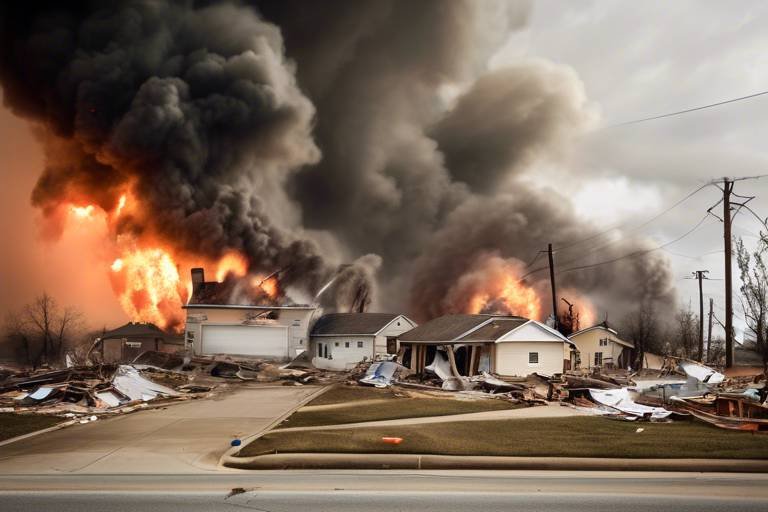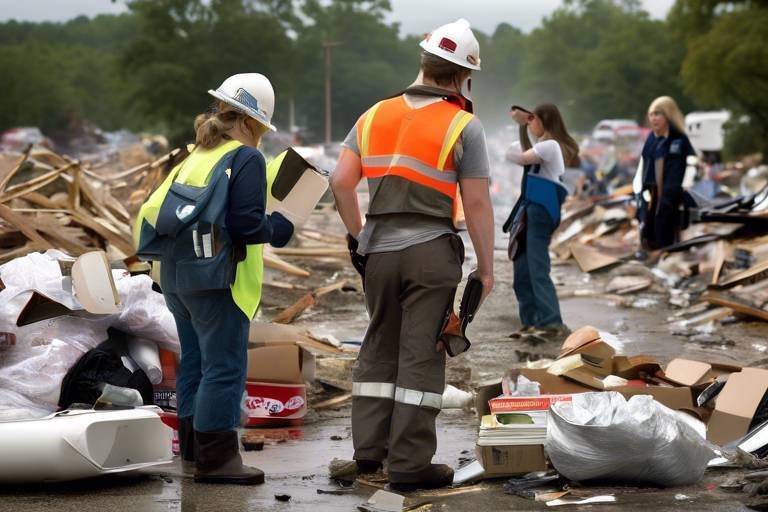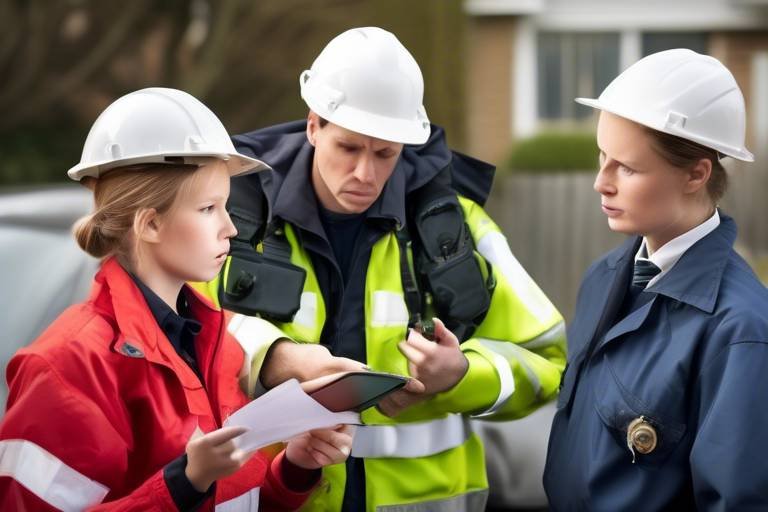Financing Emergency Preparedness - A Guide for Local Governments
When it comes to ensuring the safety and resilience of our communities, financing emergency preparedness is not just a necessity; it's a lifeline. Local governments play a pivotal role in safeguarding their residents against the unpredictable nature of disasters. But how can they effectively fund these critical initiatives? In this guide, we will explore various strategies and funding sources that local governments can utilize to enhance their emergency preparedness efforts. From understanding the importance of proactive planning to identifying diverse funding avenues, this article aims to equip local leaders with the knowledge they need to bolster community resilience in the face of crises.
Emergency preparedness is crucial for minimizing the impact of disasters. Imagine a community that can bounce back swiftly after a natural calamity—this is the power of proactive planning. By investing in resources and strategies ahead of time, local governments can protect their communities and ensure a more efficient recovery process. The significance of this investment cannot be overstated; it is about more than just funding—it's about saving lives, protecting property, and maintaining the stability of the community. When disaster strikes, those who have prepared will have a better chance of navigating the chaos. So, why wait for the storm to hit before taking action?
Local governments can tap into multiple funding sources for emergency preparedness. These resources can come from various levels of government and even private partnerships. It’s essential to be aware of the landscape of available funding to maximize the potential for successful initiatives. Federal grants, state funding, and private partnerships all play a role in supporting various emergency preparedness projects. The challenge lies in identifying which sources align best with specific needs and how to effectively access these funds. By being proactive in this area, local governments can ensure that they have the financial backing necessary to implement robust emergency preparedness plans.
Federal grants provide substantial financial support for emergency preparedness. Local governments should familiarize themselves with key federal programs that can aid in their initiatives. Understanding eligibility criteria and the application process is vital for accessing these funds. Many federal agencies, such as the Federal Emergency Management Agency (FEMA) and the Department of Homeland Security (DHS), offer targeted grants aimed at enhancing local capabilities. By leveraging these opportunities, local governments can significantly improve their emergency preparedness efforts.
The Federal Emergency Management Agency (FEMA) offers various grants for preparedness initiatives, each designed to address specific needs within communities. For instance, the FEMA Hazard Mitigation Grant Program provides funding for projects that reduce disaster risk, while the FEMA Emergency Management Performance Grant supports the development of emergency management programs. Local governments can effectively leverage these programs by understanding their objectives and aligning them with community needs. The key is to demonstrate how the proposed initiatives will enhance resilience and preparedness.
The Department of Homeland Security (DHS) also provides funding for emergency preparedness, with programs aimed at enhancing local capabilities and resilience. For example, the Urban Area Security Initiative (UASI) focuses on improving security measures in major urban areas, while the State Homeland Security Program (SHSP) allocates funds to states to address local emergency preparedness needs. Engaging with these programs can provide local governments with the necessary resources to bolster their initiatives.
Many states offer funding programs to support local emergency preparedness efforts. These state-specific initiatives can vary significantly, but they often provide valuable resources for local governments. By reviewing available programs and understanding the application processes, local leaders can tap into these funds to enhance their emergency preparedness strategies. Whether it’s through grants, loans, or technical assistance, state funding can play a critical role in building a resilient community.
Collaboration with community organizations is vital for successful emergency preparedness. Forming partnerships and engaging stakeholders can enhance resource mobilization and create a more comprehensive approach to preparedness. By working together, local governments can pool resources, share knowledge, and develop innovative solutions to address the unique challenges their communities face. This collaborative spirit not only strengthens emergency preparedness but also fosters a sense of community solidarity.
Nonprofits and NGOs play a crucial role in emergency preparedness. These organizations often have the expertise, resources, and community connections needed to support local governments in their initiatives. Strategies for collaboration can include joint training exercises, resource sharing, and community outreach programs. By engaging with these organizations, local governments can enhance their planning efforts and ensure that a diverse range of perspectives and resources are included in their emergency preparedness strategies.
Public-private partnerships can enhance funding and resources for emergency preparedness. Local governments can engage businesses to support initiatives, whether through financial contributions, in-kind donations, or volunteer efforts. These partnerships can lead to innovative solutions and greater community resilience. By fostering strong relationships with the private sector, local governments can ensure that they have the backing needed to implement effective emergency preparedness strategies.
- What are the primary sources of funding for emergency preparedness? Local governments can access federal grants, state-level funding programs, and private partnerships.
- How can local governments effectively apply for federal grants? They should familiarize themselves with eligibility criteria and application processes for specific programs.
- Why are community partnerships important for emergency preparedness? Collaborating with nonprofits and businesses enhances resource mobilization and strengthens community resilience.

Understanding the Importance of Emergency Preparedness
Emergency preparedness is not just a box to check off; it's a vital strategy that can mean the difference between chaos and calm when disasters strike. Imagine waking up to a natural disaster—whether it's a hurricane, flood, or wildfire. The first few moments are critical. Do you have a plan? Are your community resources ready to spring into action? This is where the significance of proactive planning comes into play. Investing in emergency preparedness is akin to buying insurance for your community's safety and resilience.
When local governments prioritize emergency preparedness, they are essentially building a safety net for their residents. This involves not only having the right resources in place but also ensuring that those resources are accessible and effective when needed. For instance, consider the following:
- Minimized Impact: Effective preparedness reduces the potential damage caused by disasters, saving lives and property.
- Swift Recovery: Communities that are well-prepared can bounce back faster, minimizing disruption to daily life.
- Informed Citizens: Preparedness initiatives often include public education, empowering residents to take action during emergencies.
Moreover, the ripple effect of being prepared extends beyond immediate response. It fosters a sense of community resilience, where individuals and families feel secure knowing they have a plan and the support of their local government. This is crucial in times of uncertainty. Just like a well-rehearsed fire drill at school, preparedness ensures that everyone knows their role and is ready to act when the alarm bells ring.
Furthermore, investing in emergency preparedness can lead to long-term financial benefits. By reducing the severity of disaster impacts, local governments can save on recovery costs, which often drain budgets and resources. In fact, studies have shown that every dollar spent on preparedness can save multiple dollars in recovery efforts. It's a no-brainer!
In conclusion, understanding the importance of emergency preparedness is not just about having a plan; it's about creating a culture of safety and resilience within the community. It requires commitment, resources, and collaboration among various stakeholders. As we delve deeper into the strategies and funding sources available for local governments, remember that the ultimate goal is to protect lives and ensure that our communities can withstand whatever challenges come their way.

Identifying Funding Sources
When it comes to enhancing emergency preparedness, one of the most critical steps for local governments is identifying funding sources. Without adequate resources, even the best-laid plans can fall flat. Fortunately, there is a myriad of funding options available that can help bolster emergency initiatives. By tapping into these resources, local governments can ensure they are well-equipped to respond effectively to disasters, ultimately safeguarding their communities.
First off, let's talk about federal grants. The federal government recognizes the importance of emergency preparedness and offers various financial support programs dedicated to this cause. These grants can cover everything from training exercises to purchasing essential equipment. However, it's important to note that each grant comes with its own eligibility criteria and application processes. Local governments should stay informed about these opportunities and prepare their applications carefully to maximize their chances of securing funding.
Next, we have state funding programs. Many states have established their own funding mechanisms to support local governments in emergency preparedness efforts. This can include direct grants, low-interest loans, or even matching funds for specific projects. Local governments should reach out to their state emergency management agencies to learn about available programs and how to apply. By doing so, they can tap into a valuable resource that can significantly enhance their preparedness initiatives.
In addition to federal and state funding, local governments can also explore private partnerships. Engaging with businesses and community organizations can unlock additional financial resources and in-kind support. For example, a local business may be willing to donate supplies or services that can aid in emergency preparedness efforts. Building these partnerships not only provides financial benefits but also fosters a sense of community collaboration, which is essential during times of crisis.
To summarize, identifying funding sources for emergency preparedness involves a multifaceted approach. Local governments should consider:
- Federal grants from agencies like FEMA and the Department of Homeland Security.
- State-level funding programs tailored to local needs.
- Private partnerships that can enhance resource mobilization.
By actively seeking out and leveraging these funding opportunities, local governments can significantly improve their emergency preparedness efforts, ensuring that they are ready to face any challenge that comes their way. Remember, preparedness is not just about having a plan; it’s about having the resources to execute that plan effectively.

Federal Grant Opportunities
When it comes to enhancing emergency preparedness, federal grants can be a game-changer for local governments. These grants not only provide the necessary funding but also open doors to a plethora of resources and training opportunities. Imagine having the ability to implement state-of-the-art technology to monitor weather patterns or develop community training programs that prepare residents for various emergencies. This is the power of federal grants!
One of the most significant sources of federal funding is through the Federal Emergency Management Agency (FEMA). FEMA offers a variety of grant programs aimed at bolstering local emergency preparedness initiatives. These grants are designed to assist local governments in developing comprehensive emergency plans, conducting training exercises, and acquiring essential equipment. However, it's crucial to understand the eligibility criteria and application processes associated with these grants.
For instance, FEMA's Preparedness Grants Program is a key avenue for funding. This program focuses on enhancing the capabilities of local jurisdictions to prepare for, respond to, and recover from disasters. Local governments must demonstrate a clear plan that outlines their preparedness needs and how the funds will be utilized. This process may seem daunting, but the potential benefits far outweigh the challenges.
Another significant source of funding comes from the Department of Homeland Security (DHS). DHS provides various grant opportunities aimed at improving local emergency management capabilities. This includes funding for training programs, equipment purchases, and community outreach initiatives. Local governments can tap into these resources to not only enhance their emergency response capabilities but also foster a culture of preparedness within their communities.
To give you a clearer picture, here's a brief overview of some key federal grant programs available for local governments:
| Grant Program | Agency | Purpose | Eligibility |
|---|---|---|---|
| Hazard Mitigation Grant Program | FEMA | Funds projects that reduce disaster risk | State and local governments |
| Emergency Management Performance Grant | FEMA | Supports emergency management programs | State and local governments |
| Urban Area Security Initiative | DHS | Enhances security and preparedness in urban areas | Urban areas with high-risk factors |
| Nonprofit Security Grant Program | DHS | Enhances security for nonprofits at risk of terrorism | Nonprofit organizations |
As you can see, there’s a wealth of opportunities available. Local governments should not hesitate to explore these options and apply for funding. The application process may require a bit of effort, but the long-term benefits—such as increased community resilience and improved emergency response capabilities—are well worth it. So, why not take that leap and invest in your community's safety and preparedness?
In conclusion, federal grants are a vital resource for local governments looking to bolster their emergency preparedness efforts. By leveraging these funds effectively, communities can not only prepare for disasters but also ensure a swift recovery when emergencies strike. The key is to stay informed, proactive, and ready to seize these opportunities as they arise.
- What types of projects can be funded by federal grants? Federal grants can fund a wide range of projects, including training programs, equipment purchases, and community outreach initiatives aimed at improving emergency preparedness.
- How can local governments apply for these grants? Local governments can apply for grants by submitting a detailed proposal that outlines their emergency preparedness needs and how the funds will be utilized.
- Are there specific eligibility criteria for federal grants? Yes, eligibility criteria vary by grant program, but typically, state and local governments are eligible to apply.
- Where can I find more information about available grants? You can find more information on the official websites of FEMA and DHS, where they list current grant opportunities and application guidelines.

FEMA Grants
The Federal Emergency Management Agency (FEMA) plays a pivotal role in bolstering the emergency preparedness capabilities of local governments across the United States. With a variety of grants designed specifically for this purpose, FEMA provides a financial lifeline that can significantly enhance community resilience. Understanding the types of grants available and the application process is essential for local governments looking to secure funding for their emergency preparedness initiatives.
One of the most notable programs is the Preparedness Grants Program, which aims to support state and local governments in their efforts to prepare for and respond to disasters. This program encompasses several grant opportunities, including the Emergency Management Performance Grant (EMPG), which focuses on improving emergency management capabilities. Local governments can receive funding to develop and maintain comprehensive emergency management programs, which are crucial for effective disaster response.
Another important grant is the Hazard Mitigation Grant Program (HMGP), which provides funding for projects that reduce disaster risk in communities. This grant is particularly valuable as it allows local governments to invest in long-term solutions that can save lives and reduce recovery costs in the aftermath of a disaster. For instance, communities can use HMGP funds to implement flood control measures, strengthen infrastructure, or enhance building codes.
To be eligible for FEMA grants, local governments must meet specific criteria, which often include demonstrating a clear plan for emergency preparedness and showcasing how the funding will be utilized effectively. The application process can be competitive, so it’s essential to prepare comprehensive proposals that clearly outline the intended use of the grant funds. Local governments should include detailed budgets, timelines, and expected outcomes to increase their chances of securing funding.
In addition to the traditional grant programs, FEMA also offers the Community Rating System (CRS), which incentivizes communities to engage in floodplain management practices that exceed the minimum requirements. Communities that participate in the CRS can qualify for discounts on flood insurance premiums, thereby providing a financial benefit while simultaneously enhancing their preparedness efforts.
Overall, FEMA grants serve as a vital resource for local governments aiming to strengthen their emergency preparedness initiatives. By leveraging these funds, communities can not only improve their immediate response capabilities but also invest in long-term strategies that promote resilience and sustainability in the face of disasters.
For local governments considering applying for FEMA grants, it’s advisable to stay informed about upcoming funding opportunities and deadlines. Regularly visiting the FEMA website and subscribing to newsletters can help officials remain updated on the latest grant announcements and application guidelines.

Department of Homeland Security Funding
The Department of Homeland Security (DHS) plays a pivotal role in enhancing emergency preparedness across the United States. By providing various funding opportunities, DHS empowers local governments to build robust systems that can effectively respond to and recover from disasters. Understanding these funding sources is essential for local officials who are committed to safeguarding their communities.
One of the primary funding mechanisms offered by DHS is through the Preparedness Grants Program. This program supports a wide range of initiatives aimed at improving local emergency response capabilities. Local governments can apply for grants to fund projects that enhance their planning, training, and operational readiness. The funding can be utilized for equipment purchases, training exercises, and community outreach programs. By investing in these areas, localities can significantly bolster their resilience against potential threats.
Moreover, the DHS emphasizes the importance of collaborative efforts in emergency preparedness. Through programs like the Urban Area Security Initiative (UASI), DHS provides funding specifically for high-threat urban areas. This initiative encourages collaboration between local governments and various stakeholders, including law enforcement, emergency services, and community organizations. By pooling resources and expertise, these partnerships can create a more comprehensive approach to disaster response.
In addition to UASI, the State Homeland Security Program (SHSP) allocates funds to states for enhancing their overall preparedness. This program allows states to distribute funding to local jurisdictions based on their specific needs. Local governments can utilize SHSP funds to conduct risk assessments, develop emergency plans, and conduct training exercises that prepare their personnel for real-life scenarios.
It's also important to note that DHS funding is not a one-size-fits-all solution. Each program has its own eligibility criteria and application processes. Local governments must carefully review these requirements to ensure they meet the necessary guidelines. For instance, some grants may prioritize certain types of projects or geographic areas, making it crucial for local officials to align their proposals with the funding priorities of DHS.
To help local governments navigate the complexities of DHS funding, it's beneficial to establish a dedicated team or designate a point of contact within the local government. This team can focus on grant research, application writing, and compliance monitoring. By streamlining this process, local governments can increase their chances of securing vital funding for their emergency preparedness initiatives.
In summary, the Department of Homeland Security offers a variety of funding opportunities that can significantly enhance local emergency preparedness efforts. By understanding the available programs, collaborating with community partners, and strategically applying for grants, local governments can build a resilient framework that not only protects their citizens but also fosters a culture of preparedness. As we face an uncertain future with potential threats ranging from natural disasters to terrorism, investing in these funding opportunities is not just wise—it's essential.
- What types of projects can DHS funding support? DHS funding can support a variety of projects, including training exercises, equipment purchases, and community outreach programs aimed at improving emergency preparedness.
- How can local governments apply for DHS grants? Local governments can apply for DHS grants by reviewing the eligibility criteria and application processes outlined for each specific grant program on the DHS website.
- What is the Urban Area Security Initiative (UASI)? UASI is a DHS program that provides funding to high-threat urban areas to enhance their preparedness and encourage collaboration among local stakeholders.
- Are there other funding sources besides DHS? Yes, local governments can also explore federal grants, state funding programs, and private partnerships to support their emergency preparedness initiatives.

State-Level Funding Programs
When it comes to enhancing emergency preparedness, local governments don’t have to go it alone. Many states recognize the importance of being proactive in disaster management and have established funding programs specifically designed to support local initiatives. These programs can be a game-changer, providing essential resources that can lead to improved community resilience and faster recovery times when disasters strike. But how do local governments tap into these resources? Let's dive into some key aspects.
Each state has its own set of funding opportunities, often tailored to address unique regional challenges. For instance, states prone to hurricanes may have different funding priorities compared to those that face wildfires or flooding. This means that local governments should conduct thorough research to identify which programs align best with their specific needs. Additionally, many states offer grants, loans, and technical assistance that can help local governments develop and implement effective emergency preparedness plans.
To give you a clearer picture, here’s a brief overview of what some states offer:
| State | Program Name | Funding Type | Eligibility |
|---|---|---|---|
| California | California Disaster Assistance Act | Grant | Local governments and non-profits |
| Texas | Texas Division of Emergency Management Grants | Grant | Local governments |
| Florida | Florida Emergency Management Grant Program | Grant | Counties and municipalities |
| New York | New York State Hazard Mitigation Grant Program | Grant | Local governments and state agencies |
It's essential for local governments to stay updated on the application processes and deadlines for these programs. Often, states will have specific requirements that must be met to qualify for funding, which can include detailed project proposals, budgets, and even community engagement plans. By investing time in understanding these requirements, local governments can significantly enhance their chances of securing much-needed funding.
Moreover, many states conduct workshops and informational sessions aimed at guiding local officials through the funding application process. Participating in these sessions can provide invaluable insights and tips on how to craft a successful application. It’s like having a roadmap that leads you through the often complex landscape of state funding.
In conclusion, state-level funding programs are a vital resource for local governments looking to bolster their emergency preparedness efforts. By leveraging these programs, communities can not only enhance their resilience but also ensure that they are better equipped to handle disasters when they arise. So, if you're a local government official, make sure to explore the funding opportunities available in your state and take proactive steps to secure the resources your community needs.

Building Community Partnerships
When it comes to emergency preparedness, collaboration is key. Local governments cannot tackle the challenges of disasters alone; they need to forge strong partnerships with community organizations, businesses, and residents. Think of it as a well-oiled machine where each part plays a crucial role in ensuring the community runs smoothly during crises. By building these partnerships, local governments can enhance resource mobilization, improve response times, and ultimately increase community resilience.
One of the most effective ways to strengthen these partnerships is through open communication and engagement. Local governments should reach out to community stakeholders and hold regular meetings to discuss emergency plans, share resources, and gather input. This not only fosters a sense of community but also empowers residents to take an active role in their safety and preparedness. Imagine a neighborhood where everyone knows their role during an emergency—it's not just about having a plan; it's about having a community that supports one another.
Nonprofits and non-governmental organizations (NGOs) are often at the forefront of emergency response efforts, providing essential services and support. By engaging with these organizations, local governments can tap into a wealth of knowledge and resources. For instance, a local food bank might have expertise in logistics that can be invaluable during a disaster. By working together, these organizations can create a network of support that enhances the overall effectiveness of emergency preparedness initiatives.
Public-private partnerships also play a significant role in enhancing emergency preparedness. Businesses can offer resources, funding, and expertise that local governments might not have access to otherwise. For example, a local tech company could provide software solutions for better communication during emergencies, while a construction firm might assist in rebuilding efforts post-disaster. By engaging the private sector, local governments can create a robust support system that benefits the entire community.
In conclusion, building community partnerships is not just an option; it's a necessity for effective emergency preparedness. By fostering collaboration among various stakeholders, local governments can enhance their ability to respond to disasters, protect their residents, and ultimately build a more resilient community. Remember, in the face of adversity, it’s the strength of our connections that can make all the difference.
- What is the role of local governments in emergency preparedness? Local governments are responsible for planning, coordinating, and implementing emergency preparedness strategies to protect their communities.
- How can community organizations help in emergency preparedness? Community organizations can provide resources, expertise, and volunteer support, enhancing the overall effectiveness of emergency response efforts.
- What are public-private partnerships? These partnerships involve collaboration between local governments and private businesses to enhance resources and support for emergency preparedness initiatives.
- Why is communication important in building community partnerships? Open communication helps to build trust, gather input, and ensure that all stakeholders are informed and engaged in emergency planning efforts.

Engaging Nonprofits and NGOs
When it comes to emergency preparedness, local governments often find themselves in a unique position to collaborate with nonprofits and non-governmental organizations (NGOs). These organizations are not just additional resources; they are vital partners that bring a wealth of knowledge, community ties, and specialized skills to the table. By engaging with these entities, local governments can enhance their emergency plans and ensure a more resilient community. But how exactly can these collaborations be structured to maximize effectiveness?
First off, it's essential to recognize the strengths that nonprofits and NGOs bring. Many of these organizations have established networks and a deep understanding of community needs, which can be invaluable during a disaster. For instance, they can help identify vulnerable populations, provide training on emergency response, and mobilize volunteers swiftly. It's like having a secret weapon in your back pocket—one that can make all the difference when the chips are down.
One effective strategy for engaging nonprofits and NGOs is to create formal partnerships. This could involve signing a memorandum of understanding (MOU) that outlines roles, responsibilities, and expectations. Such agreements ensure that everyone is on the same page and can facilitate smoother collaboration when emergencies arise. Additionally, local governments can provide resources such as training and funding to help these organizations build their capacity for emergency response. In this way, it becomes a win-win situation, where both parties can enhance their capabilities.
Moreover, hosting joint training sessions can be an excellent way to strengthen these partnerships. By bringing together government officials, nonprofit staff, and community volunteers, local governments can foster a sense of unity and shared purpose. For example, conducting disaster simulations or preparedness workshops can not only improve skills but also build trust among partners. It’s like practicing for a big game; the more you prepare together, the better you’ll perform when it really matters.
Another important aspect is communication. Establishing clear lines of communication ensures that everyone knows who to contact during a crisis and what information needs to be shared. Regular meetings can help keep all parties informed and engaged. Consider setting up a community emergency preparedness network where nonprofits, NGOs, and local government agencies can share updates, resources, and best practices. This network can serve as a lifeline during emergencies, allowing for rapid information sharing and coordinated responses.
Finally, it’s crucial to acknowledge the contributions of these organizations publicly. Recognizing their efforts not only boosts morale but also encourages ongoing collaboration. Whether it’s through social media shout-outs, community events, or formal recognition awards, showing appreciation can strengthen the bond between local governments and nonprofits/NGOs. After all, teamwork makes the dream work, especially when it comes to keeping communities safe and prepared.
Q: Why should local governments engage with nonprofits and NGOs for emergency preparedness?
A: Nonprofits and NGOs have established networks and expertise that can enhance emergency preparedness efforts. They understand community needs and can mobilize resources quickly during a crisis.
Q: What types of partnerships can be formed between local governments and these organizations?
A: Partnerships can range from formal agreements like memorandums of understanding (MOUs) to collaborative training sessions and community engagement initiatives.
Q: How can local governments ensure effective communication with nonprofits and NGOs?
A: Establishing regular meetings and creating a community emergency preparedness network can help maintain open lines of communication and ensure everyone is informed during emergencies.
Q: What are some examples of successful collaborations?
A: Successful collaborations often involve joint training exercises, resource sharing, and coordinated response efforts during disasters, showcasing the strengths of both parties.

Public-Private Partnerships
Public-private partnerships (PPPs) are a powerful tool for local governments looking to bolster their emergency preparedness initiatives. Imagine a scenario where the strengths of both the public sector and private businesses converge, creating a formidable force for community resilience. When local governments collaborate with private entities, they can leverage additional resources, expertise, and innovative solutions that might otherwise be out of reach. This collaboration not only enhances the quality of emergency preparedness programs but also ensures that communities are better equipped to handle unforeseen disasters.
One of the most significant advantages of PPPs is the ability to share risks and responsibilities. In traditional funding models, local governments often bear the entire burden of planning and executing emergency preparedness strategies. However, through partnerships with private companies, they can distribute these responsibilities. For instance, a local government might team up with a tech firm to develop an advanced alert system for emergencies. This not only reduces the financial strain on the government but also taps into the private sector's expertise in technology and innovation.
Moreover, engaging businesses in emergency preparedness can lead to a wealth of resources that enhance community readiness. Companies can provide funding, equipment, and even skilled personnel to support local initiatives. For example, a local construction company might offer its services to build emergency shelters, while a logistics firm could assist in planning effective supply chain strategies for disaster response. Such contributions can significantly improve the speed and efficiency of response efforts, ultimately saving lives and minimizing damage.
However, establishing successful public-private partnerships requires clear communication and mutual understanding of goals. Local governments must articulate their needs and expectations while also being open to the ideas and capabilities that private partners bring to the table. Regular meetings and collaborative planning sessions can help bridge any gaps and ensure that all parties are aligned in their efforts. Additionally, creating formal agreements that outline the roles and responsibilities of each partner can prevent misunderstandings and foster a spirit of cooperation.
Another vital aspect of PPPs is the potential for innovation. Private companies often operate in highly competitive environments, driving them to develop cutting-edge solutions and technologies. By partnering with these businesses, local governments can gain access to new tools and methodologies that enhance their emergency preparedness strategies. For instance, utilizing data analytics to predict disaster scenarios or implementing mobile applications for community alerts can be game-changers in how a locality prepares for and responds to emergencies.
Ultimately, the success of public-private partnerships in emergency preparedness hinges on building trust and fostering a collaborative culture. When local governments and private entities work together with a shared vision, they can create a resilient framework that not only prepares communities for disasters but also strengthens the social fabric. As we move forward, it is essential for local governments to actively seek out partnerships with the private sector, recognizing that together, they can achieve much more than they could alone.
- What are public-private partnerships? Public-private partnerships are collaborative agreements between government entities and private sector companies aimed at delivering public services or projects, including emergency preparedness.
- How can local governments benefit from public-private partnerships? Local governments can access additional resources, expertise, and innovative solutions, share risks, and enhance the efficiency of emergency preparedness initiatives through these partnerships.
- What types of businesses can participate in public-private partnerships for emergency preparedness? A wide range of businesses can participate, including technology firms, construction companies, logistics providers, and local service organizations.
- How can local governments ensure successful partnerships? Clear communication, mutual understanding of goals, regular meetings, and formal agreements outlining roles and responsibilities are essential for successful partnerships.
Frequently Asked Questions
-
Why is emergency preparedness important for local governments?
Emergency preparedness is essential for local governments because it helps minimize the impacts of disasters on communities. By planning ahead and investing in resources, local governments can protect their residents and ensure a swift recovery in the aftermath of emergencies. Think of it as having an umbrella ready before it starts to rain; it’s all about being proactive!
-
What are some federal grant opportunities available for emergency preparedness?
Local governments can access various federal grants, with the Federal Emergency Management Agency (FEMA) being a primary source. FEMA offers programs specifically designed to enhance preparedness initiatives. These grants can cover everything from training to equipment purchases. The key is to understand the eligibility criteria and application processes for these grants to make the most of them.
-
How can local governments identify state-level funding programs?
Many states have specific funding programs aimed at supporting local emergency preparedness efforts. Local governments can identify these programs by visiting their state’s emergency management website or reaching out to state agencies. Networking with other local governments can also provide insights into successful funding strategies.
-
What role do nonprofits and NGOs play in emergency preparedness?
Nonprofits and NGOs are vital partners in emergency preparedness. They often have resources, expertise, and community connections that can enhance local efforts. By collaborating with these organizations, local governments can improve planning, resource sharing, and overall community resilience. It’s like teaming up with a friend who knows the best shortcuts when navigating through a tough situation!
-
How can public-private partnerships benefit emergency preparedness initiatives?
Public-private partnerships can significantly enhance funding and resources for emergency preparedness. By engaging local businesses, governments can tap into additional resources, expertise, and innovative solutions. These partnerships can lead to more comprehensive preparedness initiatives, ultimately leading to a stronger, more resilient community.



















